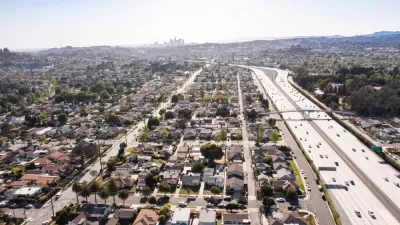A Habitat for Humanity Project in Silicon Valley is stymied by an effective, CEQA-wielding attorney who doesn't want his home office views obstructed and more traffic in his neighborhood.
Note from publisher CALmatters: This story is part of The California Dream project, a statewide nonprofit media collaboration that involves many partners including Capital Public Radio with support provided by the Corporation for Public Broadcasting. Click here to access the audio version.
The site for the 20-unit building is a vacant lot within walking distance to downtown Redwood City and its Caltrain station, according to the nonprofit developer, Habitat for Humanity Greater San Francisco.
Unfortunately for the 20 prospective families earning up to 80 percent of the area median income, the lot is within view of the office of a criminal defense attorney, Geoffrey Carr, who has become an expert at applying the California Environmental Quality Act (CEQA) to stop development, reports Ben Bradford of Capital Public Radio. For CEQA critics, 612 Jefferson Avenue "is a poster child for the need for reform."
The six-story Habitat building, although half the size of its original proposal, would block the views from the rear window of Carr's office, which is also his home. "The lawsuit against Habitat for Humanity is Carr’s second, and the fourth he’s threatened," by weaponizing CEQA.
For Carr, CEQA is the best tool to defend against what he sees as greedy developers and complacent city officials.
Maureen Sedonaen, CEO of the Habitat for Humanity chapter, says Carr’s actions are not simply impeding encroaching development: They hurt needy residents.
Habitat is being defended pro bono by Jennifer Hernandez, an attorney at Holland & Knight and one of the state’s most vocal advocates for change to the [CEQA] law. “This is not about the environment,” she said. Anyone can file a CEQA lawsuit by "challenging that a project has violated the approval process."
Hernandez analyzed CEQA lawsuits in the Bay Area over a three-year period and found prominent environmental groups brought only 13 percent of the cases.
“CEQA litigation is not a battle between ‘business’ and ‘enviros’ … [It] is primarily the domain of Not In My Backyard (NIMBY) opponents and special interests such as competitors and labor unions seeking non-environmental outcomes.” [The Planning Report via Planetizen, December 27, 2015.]
In defense of CEQA
"UC Berkeley environmental law professor Eric Biber is part of a team researching the barriers to new housing in California," adds Bradford. "The initial leg of the study looked at projects with five units or more approved in five Bay Area cities, how long it took for their approval, and what steps the cities required."
In San Francisco, Oakland, Redwood City, Palo Alto and San Jose, Biber says CEQA was not an overriding obstacle.
“I think it probably gets more attention than it deserves,” he said. “I like to think of CEQA as a symptom, not a cause of the underlying challenges we face in producing more housing in urban areas in California.”
Bradford goes on to describe why reforming CEQA won't be the silver bullet proponents think it may be. In fact, the Habitat case conforms to Biber's findings.
According to a Los Angeles Times article last February on the report (via Planetizen), "local land use processes, specifically the approval process, rather than the California Environmental Quality Act, is the main impediment to housing production in California."
Additional reading: "Redwood City sued over approval of downtown affordable housing," San Mateo Daily Journal, June 26, 2017.
FULL STORY: Is California’s legacy environmental law protecting the state’s beauty or blocking affordable housing?

Planetizen Federal Action Tracker
A weekly monitor of how Trump’s orders and actions are impacting planners and planning in America.

San Francisco's School District Spent $105M To Build Affordable Housing for Teachers — And That's Just the Beginning
SFUSD joins a growing list of school districts using their land holdings to address housing affordability challenges faced by their own employees.

The Tiny, Adorable $7,000 Car Turning Japan Onto EVs
The single seat Mibot charges from a regular plug as quickly as an iPad, and is about half the price of an average EV.

With Protected Lanes, 460% More People Commute by Bike
For those needing more ammo, more data proving what we already knew is here.

In More Metros Than You’d Think, Suburbs are Now More Expensive Than the City
If you're moving to the burbs to save on square footage, data shows you should think again.

The States Losing Rural Delivery Rooms at an Alarming Pace
In some states, as few as 9% of rural hospitals still deliver babies. As a result, rising pre-term births, no adequate pre-term care and "harrowing" close calls are a growing reality.
Urban Design for Planners 1: Software Tools
This six-course series explores essential urban design concepts using open source software and equips planners with the tools they need to participate fully in the urban design process.
Planning for Universal Design
Learn the tools for implementing Universal Design in planning regulations.
Smith Gee Studio
City of Charlotte
City of Camden Redevelopment Agency
City of Astoria
Transportation Research & Education Center (TREC) at Portland State University
US High Speed Rail Association
City of Camden Redevelopment Agency
Municipality of Princeton (NJ)





























